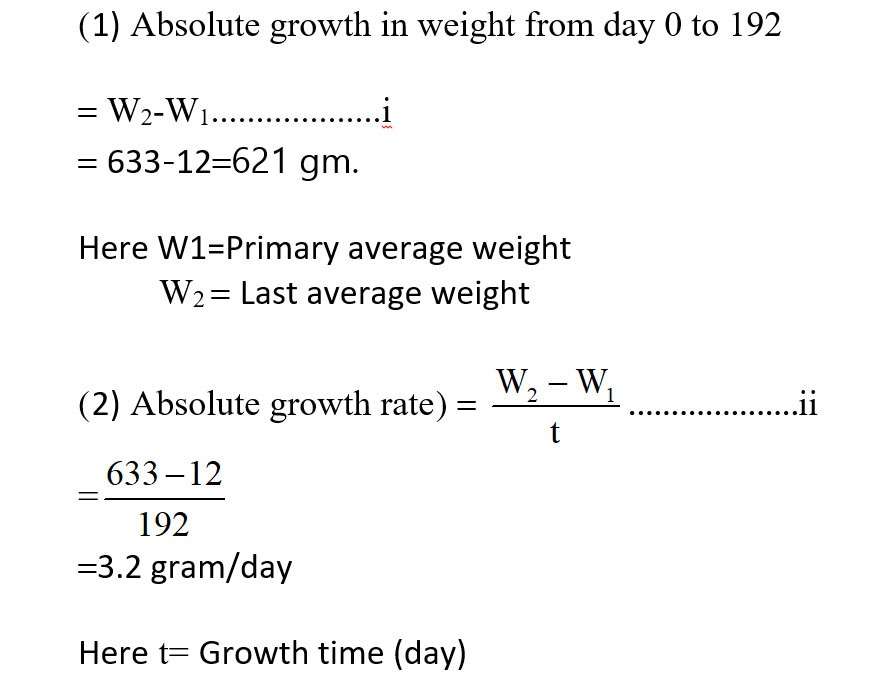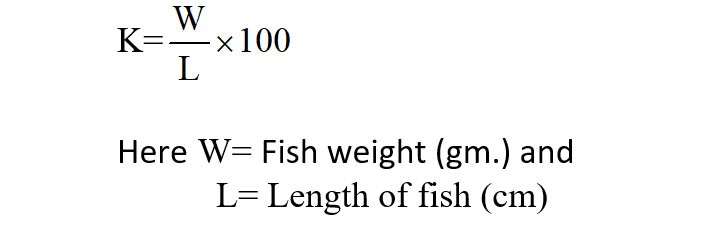Significant parameters of intensive study of fish biology are observation of growth. It provides ideas about the health of single fish and the population. The growth of an organism can be defined by changes in body size over time. Since the age and growth of the fish are closely related, the age and growth rate of the fish are determined simultaneously. Adequate fish food supply and other favorable environment accelerate the growth of fish. The growth rate of fish varies from species to species and even the growth rate of fish of the same species varies due to different environmental factors and it is influenced by different types of factors/influencers.
Growth does not always increase in the whole life of fish and shrimp. In tropical countries, the type of growth is deeply related to food adequacy and seasonal changes in water temperature. In temperate regions other influences such as rainfall, salinity, etc. have an effect on growth. The distribution of energy varies with the stage of development of fish and shrimp. Larvae and young fish use energy mainly for growth, while adult and sexually mature animals expend energy for their reproduction and maintenance.
Growth Recording
The amount of growth of a fish or shrimp depends on a complete change with length or weight. The amount of growth is determined by the time interval (days, weeks, or months). This is called growth rate. The table-1 shows the length and weight gain rate of Tambaqui-Colosoma macropomum. The following equation is used as an example:

The rate of total growth rather than total growth is a very appropriate measure of growth. Fish farmers around the world use such measurements. Such measurements are often used by ANOVA to determine the population of fish or shrimp.
Table-1: Length and weight gain rate in Tambaqui-Colosoma macropomum
|
Day |
Length (cm) |
Weight (gm) |
|---|---|---|
|
0 |
8.9 |
12 |
|
31 |
18.3 |
113 |
|
66 |
25.4 |
293 |
|
94 |
28.1 |
388 |
|
128 |
30.2 |
507 |
|
156 |
31.7 |
551 |
|
192 |
35.0 |
633 |
Estimating Survival Rate
In determining the amount of food allotted, it is very important to determine the survival rate of fish or shrimp in a particular farming method. In case of intensive fish farming, it is possible to count the fish accurately while transferring from hatchery to pond, tank or cage. The next step is to recalculate when the fish is stored in the pond. Fish are counted by hand or automatic counting machine. The number of fish is calculated with a single weight of fish and transferred to the stocking pond.
After the fish are transferred to the pond, the survival rate is calculated by counting the number of daily deaths and subtracting the weight of the dead fish from the standing biomass. Death depends on the nature of the pond and the removal of the fish. Having clear water in the tank or raceway makes it easy to count and remove dead fish every day.
Determining the mortality rate of fish in ponds is more complicated. Dead fish at the bottom of deep water bodies cannot be easily seen or counted and have to be counted daily by diving or pulling nets. In the case of fish farming in ponds, the death of the bottom fish remains out of the calculation and the farmers determine the average death rate of the fish based on the previous stock and harvesting data.
Factors Affecting Growth Rate
The growth rate of fish is more variable and it depends on numerous environmental factors. Such as temperature, amount of dissolved oxygen, ammonia, salinity, photoperiod, level of competition, quality of food consumed, age of fish, maturity etc. Temperature is a very important environmental factor that affects the growth rate of fish along with other factors. Since the maximum food intake for further growth of fish is dependent on temperature. For example, at a temperature of 15 degrees C, the growth rate of salmon is highest.
The level of dissolved oxygen depends on the temperature and it is also an important factor that affects the growth of fish. If the amount of dissolved oxygen falls below a certain level, the fish are likely to be deprived of extra gaseous energy for growth and reproduction. If high levels of ammonia are present in the water, it slows down the growth rate of the fish. The growth rate also depends on the density rate of the population. High density reduces growth rate whereas low density increases growth rate. The growth rate of fish is also low due to competition for food. Competition can be both intra- and inter specific.
Adequacy of food depends on temperature and it also depends on seasonal changes which affect the growth rate. When there is enough food in summer, the growth of fish is faster and in winter, the growth slows down. Similarly photoperiod also has an effect on seasonal growth. Age and maturity are also important influencers. The fish grows rapidly in its first few months or years until it reaches maturity. Later, most of the energy is used to grow the genital organs, which reduces the rate of physical growth. The growth rate of mature fish is much lower than that of immature fish. So the single length per mature fish is much stronger than that of the immature fish, it tends to be for larger genital organs. This is shown by the higher condition factor (K). The condition factor indicates the condition of the fish over a period of time and it expresses the ratio of the length to the weight of the fish which is calculated using the following formula:

Fisheries biologists use condition factors (K) as indicators of the health of fish populations. K is high for adequate food which helps in growth of fish body and genital organs.
Regulation of Growth
The growth of fish is regulated by certain hormones. This type of hormone is called growth hormone and is secreted by the pituitary gland. Hypophysectomy inhibits growth in different species whereas growth rate increases when mammals growth hormone inject into the body. It accelerates the rate of food change. The effects of thyroid hormone, triiodothyronine (T3) accelerate the growth rate of salmon and trout in particular. According to Lawn and Matty (1982), when androgens are added to food, the rate of food change in the common carp increases or accelerates the growth rate.
Purpose of determining the age and growth of fish
The age and growth of the fish are determined for the following purposes:
- To determine the mortality rate;
- To determine the age of a particular species in sexual maturity;
- To determine the size and age of the fish for fishing purposes;
- Comparing the growth rate of fish in different reservoirs in favorable and unfavorable environment;
- In determining the annual variability of fish population in a particular reservoir.
